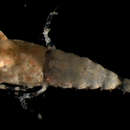pt-BR
nomes no trilho de navegação


Crangonidae is a family of shrimp, of the superfamily Crangonoidea, including the commercially important species Crangon crangon. Its type genus is Crangon. Crangonid shrimps' first pair of pereiopods have partially chelate claws that they use to capture their prey. They burrow shallowly into sediment on the sea floor, and feed on bivalves, crustaceans, polychaetes, and some small fish.[1]
Two fossil species are known: Crangon miocenicus, discovered in 2001 in the early Miocene of the north Caucasus in Russia, and Morscrangon acutus, discovered in 2006 in the fur formation (early Eocene) in Denmark.[2]
Twenty-four genera are included in the family:[3]
Crangonidae is a family of shrimp, of the superfamily Crangonoidea, including the commercially important species Crangon crangon. Its type genus is Crangon. Crangonid shrimps' first pair of pereiopods have partially chelate claws that they use to capture their prey. They burrow shallowly into sediment on the sea floor, and feed on bivalves, crustaceans, polychaetes, and some small fish.
Two fossil species are known: Crangon miocenicus, discovered in 2001 in the early Miocene of the north Caucasus in Russia, and Morscrangon acutus, discovered in 2006 in the fur formation (early Eocene) in Denmark.
Twenty-four genera are included in the family:
Aegaeon Agassiz, 1846 Argis Krøyer, 1842 Crangon Fabricius, 1798 Lissocrangon Kuris & Carlton, 1977 Lissosabinea Christoffersen, 1988 Mesocrangon Zarenkov, 1965 Metacrangon Zarenkov, 1965 †Morscrangon Garassino & Jakobsen, 2005 Neocrangon Zarenkov, 1965 Notocrangon Coutière, 1900 Paracrangon Dana, 1852a Parapontocaris Alcock, 1901 Parapontophilus Christoffersen, 1988 Philocheras Stebbing, 1900 Placopsicrangon Komai & Chan, 2009 Pontocaris Bate, 1888 Pontophilus Leach, 1817 Pseudopontophilus Komai, 2004 Prionocrangon Wood-Mason & Alcock, 1891 Rhynocrangon Zarenkov, 1965 Sabinea J. C. Ross, 1835 Sclerocrangon Sars, 1883 Syncrangon Kim & Hayashi, 2003 Vercoia Baker, 1904